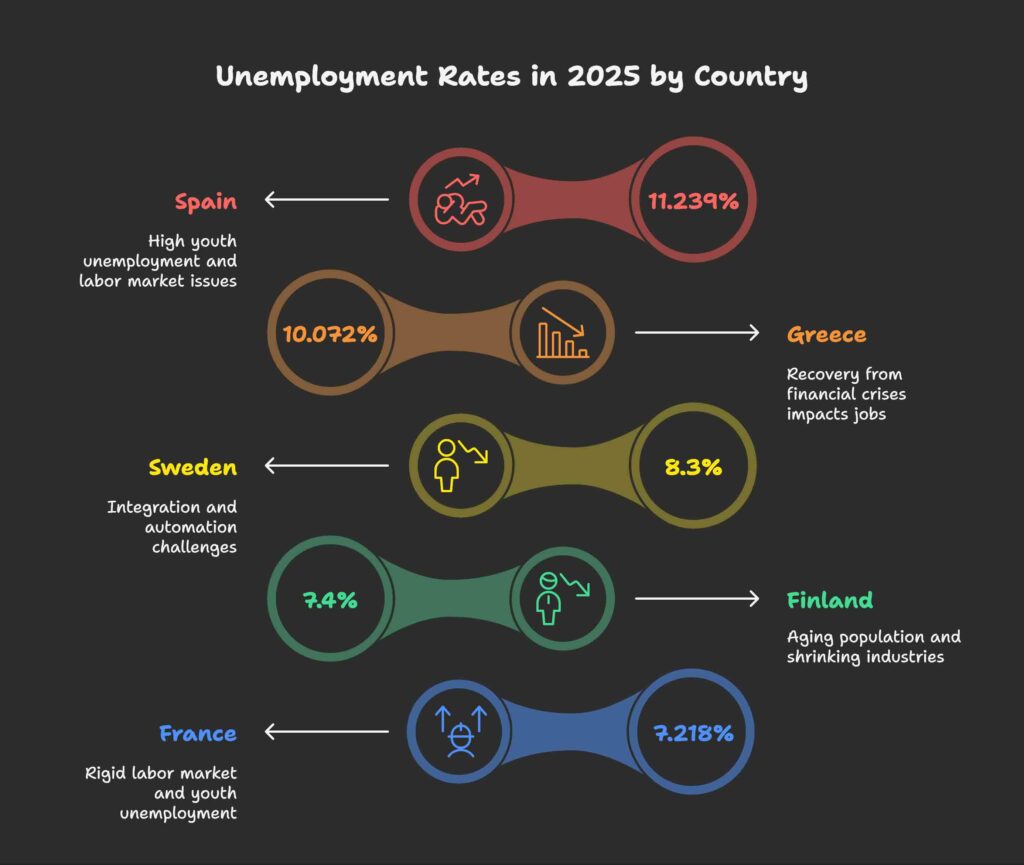Unemployment rates aren’t just statistics, they reflect the state of job opportunities and market conditions worldwide. If you’re curious about how your local job market stacks up against the best and worst employment landscapes globally, this article presents the most accurate data available, sourced directly from the International Monetary Fund (IMF).
Whether you’re considering options abroad, evaluating your local market, or simply interested in global employment trends, this article delivers reliable insights to guide your understanding of today’s job markets in first world countries.
> Table Of Content:
I. The 10 Worst Job Markets in 2025
II. The 10 Best Job Markets in 2025
III. Surprising Major Countries Missing
IV. Table of All Countries Between Best And Worst
I. The 10 Worst Job Markets in 2025
Based on unemployment rates in 2025, these are the 10 countries with the most challenging job markets. The data, sourced from the International Monetary Fund (IMF), highlights significant employment challenges faced by these nations.
1. Spain – 11.239%
Spain holds the highest unemployment rate among first-world countries in 2025. Despite its strong tourism sector and vibrant economy, the country struggles with structural challenges in its labor market. Long-standing issues like high youth unemployment, temporary job contracts, and limited opportunities in rural areas exacerbate the situation. Spain’s labor reforms have shown progress, but the road to significant improvement remains long.
2. Greece – 10.072%
Greece continues to face a challenging job market due to its economic recovery from past financial crises. The country’s unemployment rate is largely driven by a combination of public sector inefficiencies, a lack of diversified industries, and youth unemployment. Although tourism and shipping sectors are robust, they alone cannot offset broader labor market difficulties.
3. Sweden – 8.3%
Sweden’s unemployment rate is surprisingly high compared to other Nordic countries. While its welfare system remains one of the best globally, Sweden faces challenges with integrating immigrants and maintaining employment levels in traditional industries. Ongoing automation and economic transitions contribute to elevated unemployment figures.

4. Finland – 7.4%
Finland’s job market is affected by slow economic growth and demographic changes, such as an aging population. Sectors like manufacturing and forestry, which historically provided significant employment, have been shrinking due to automation and global competition. Although Finland invests heavily in education and innovation, job creation has lagged.
5. France – 7.218%
France’s unemployment challenges stem from labor market rigidities, including strict regulations on hiring and firing. While the government has introduced reforms to address these issues, the effects are yet to materialize significantly. Youth unemployment remains a pressing concern, with many struggling to find stable employment opportunities.
6. Estonia – 7.122%
Estonia, a leader in digital innovation, is surprisingly listed among the worst job markets due to structural imbalances. The country struggles with retaining talent, as many skilled workers emigrate for better opportunities. Additionally, certain rural regions face limited job creation compared to urban centers like Tallinn.
7. Lithuania – 7.1%
Lithuania’s high unemployment rate is influenced by workforce emigration and economic transitions. While its tech sector is growing rapidly, other industries, such as agriculture and manufacturing, face challenges. The country is working on improving job opportunities through investments in education and infrastructure.
8. Italy – 6.6%
Italy continues to face difficulties in its labor market, driven by economic stagnation, regional disparities, and high youth unemployment. Southern Italy remains particularly affected, with limited industrial development and fewer job opportunities. Efforts to reform the labor market are underway, but tangible improvements have been slow.
9. Latvia – 6.498%
Latvia faces labor market issues similar to its Baltic neighbors. High emigration rates among the working-age population have created skill shortages in key industries. While the government is focused on attracting foreign investment and boosting economic growth, these efforts have yet to translate into significant job creation.
10. Portugal – 6.416%
Portugal’s unemployment rate, though lower than in past years, remains a concern. Challenges include regional disparities, reliance on seasonal industries, and limited opportunities in high-value sectors. While tourism has driven growth, other industries struggle to generate sufficient employment.
These nations represent the most challenging environments for job seekers in 2025. Common challenges include structural inefficiencies, limited industrial growth, and mismatches between workforce skills and market demands. For those navigating these markets, understanding these dynamics is key to making informed career decisions.

Also Read: Why It’s Tougher Than Ever To Find A Job Today? – Job Hunt Dilemma
II. The 10 Best Job Markets in 2025
The following countries stand out for their exceptionally low unemployment rates, highlighting robust labor markets that provide favorable conditions for job seekers. Based on IMF data, these nations demonstrate economic stability, policy efficiency, and well-structured industries, making them ideal locations for employment opportunities.
10. United Kingdom – 4.1%
The United Kingdom maintains a relatively low unemployment rate in 2025 due to its diversified economy and robust service sector. Key industries like finance, technology, and healthcare continue to drive employment opportunities. However, regional disparities exist, with stronger job prospects in areas like London compared to smaller cities.
9. Iceland – 3.8%
Iceland boasts one of the lowest unemployment rates in Europe, reflecting its strong labor market. Tourism, renewable energy, and fishing are vital industries supporting the country’s economy. Iceland’s commitment to sustainable development and social policies contributes to job stability.
8. Norway – 3.8%
Norway’s robust economy is supported by oil and gas exports, as well as investments in renewable energy and technology. The government’s strong social safety nets and proactive employment policies ensure low unemployment rates. Norway’s labor market is also characterized by high wages and favorable working conditions.
7. Poland – 3.307%
Poland has emerged as a top performer in the European job market. Its economic growth is driven by manufacturing, IT, and outsourcing sectors, creating substantial job opportunities. Additionally, government reforms and investments in infrastructure have improved overall employment conditions.
6. Germany – 3.152%
Germany continues to excel with a thriving job market fueled by its strong industrial base and advanced technology sector. The country’s emphasis on vocational training and apprenticeships ensures a steady supply of skilled workers, keeping unemployment rates low.
5. Malta – 3.009%
Malta’s small but dynamic economy benefits from a strong financial services sector, tourism, and gaming industries. The country’s business-friendly policies attract international companies, creating diverse job opportunities for both locals and expatriates.

4. South Korea – 3.0%
South Korea’s advanced technology sector and export-driven economy support its low unemployment rate. Major industries like electronics, automobiles, and shipbuilding provide significant employment. Government initiatives also focus on innovation and entrepreneurship, further boosting job creation.
3. Japan – 2.5%
Japan’s low unemployment rate reflects its strong economy and high demand for skilled labor. The country’s aging population has led to labor shortages, particularly in healthcare, technology, and manufacturing, prompting businesses to actively seek talent.
2. Switzerland – 2.5%
Switzerland’s low unemployment rate is driven by its highly developed financial services sector and advanced manufacturing industries. The country’s political stability, high wages, and excellent quality of life make it an attractive destination for job seekers worldwide.
1. Singapore – 1.9%
Singapore leads the rankings with the lowest unemployment rate among first-world countries in 2025. The country’s robust economy, driven by finance, trade, and technology sectors, ensures ample job opportunities. Proactive government policies and a focus on innovation further solidify Singapore’s position as the best job market globally.
These ten countries represent the best job markets in 2025, offering abundant opportunities for job seekers. Their success highlights the importance of economic stability, targeted policies, and industry diversification in fostering sustainable employment conditions.
III. Surprising Major Countries Missing from the Best Job Market List
While the list of the top 10 best job markets highlights countries with exceptionally low unemployment rates, it’s worth noting that some globally influential nations are absent from the rankings despite their significant economic power. Here’s a look at a few major countries with notable unemployment rates in 2025:

1. United States – 4.36%
The United States, often regarded as an economic powerhouse, does not make the top 10 due to its unemployment rate of 4.4%. Although relatively low, this figure reflects regional disparities and the challenges faced by sectors such as manufacturing and retail. Despite this, the U.S. remains a hub for innovation, technology, and entrepreneurship, attracting job seekers worldwide.
2. Australia – 4.3%
Australia’s unemployment rate, matching that of the United States, excludes it from the best job markets list. While the country enjoys a strong economy driven by mining, agriculture, and tourism, certain regions and demographics face persistent challenges in securing stable employment. However, Australia continues to offer attractive job opportunities for skilled workers, particularly in healthcare and technology.
3. Canada – 6.245%
Canada’s unemployment rate places it outside the top-performing job markets, despite its reputation for a strong and stable economy. Factors such as regional variations and industry-specific challenges contribute to its higher rate. Nonetheless, Canada’s job market remains robust in sectors like natural resources, technology, and education, offering numerous opportunities for workers across various fields.
These major countries demonstrate that economic power alone does not guarantee low unemployment rates. Internal challenges, policy decisions, and structural inefficiencies play significant roles in shaping a nation’s labor market performance. Addressing these issues will be crucial for these economies to improve employment conditions and compete with the top-ranking nations.
IV. Table of All Countries Between Best And Worst
Sorted From worst to best:
| Country | Subject Descriptor | Units | 2025 |
| Spain | Unemployment rate | Percent of total labor force | 11.239 |
| Greece | Unemployment rate | Percent of total labor force | 10.072 |
| Sweden | Unemployment rate | Percent of total labor force | 8.3 |
| Finland | Unemployment rate | Percent of total labor force | 7.4 |
| France | Unemployment rate | Percent of total labor force | 7.218 |
| Italy | Unemployment rate | Percent of total labor force | 7.164 |
| Estonia | Unemployment rate | Percent of total labor force | 7.122 |
| Lithuania | Unemployment rate | Percent of total labor force | 7.1 |
| Latvia | Unemployment rate | Percent of total labor force | 6.498 |
| Portugal | Unemployment rate | Percent of total labor force | 6.416 |
| Canada | Unemployment rate | Percent of total labor force | 6.245 |
| Luxembourg | Unemployment rate | Percent of total labor force | 5.915 |
| Belgium | Unemployment rate | Percent of total labor force | 5.7 |
| Austria | Unemployment rate | Percent of total labor force | 5.557 |
| New Zealand | Unemployment rate | Percent of total labor force | 5.1 |
| Cyprus | Unemployment rate | Percent of total labor force | 5.073 |
| Australia | Unemployment rate | Percent of total labor force | 4.4 |
| Ireland | Unemployment rate | Percent of total labor force | 4.393 |
| United States | Unemployment rate | Percent of total labor force | 4.36 |
| Netherlands | Unemployment rate | Percent of total labor force | 4.2 |
| United Kingdom | Unemployment rate | Percent of total labor force | 4.1 |
| Iceland | Unemployment rate | Percent of total labor force | 3.8 |
| Norway | Unemployment rate | Percent of total labor force | 3.8 |
| Poland | Unemployment rate | Percent of total labor force | 3.307 |
| Germany | Unemployment rate | Percent of total labor force | 3.152 |
| Malta | Unemployment rate | Percent of total labor force | 3.009 |
| South Korea | Unemployment rate | Percent of total labor force | 3 |
| Japan | Unemployment rate | Percent of total labor force | 2.5 |
| Switzerland | Unemployment rate | Percent of total labor force | 2.5 |
| Singapore | Unemployment rate | Percent of total labor force | 1.9 |



